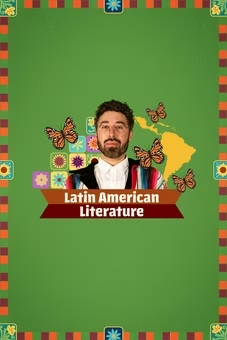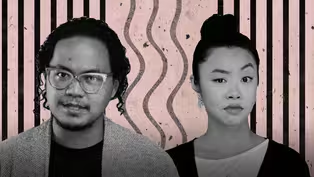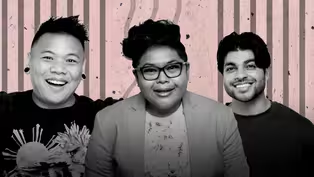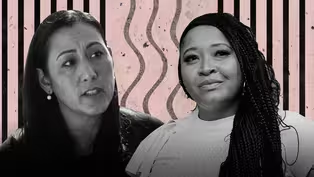
Why “The China Virus” Has Always Been A Part Of U.S. History
Season 1 Episode 1 | 9mVideo has Closed Captions
This xenophobic sentiment has resulted in a cycle of violence dating back to the 1800s.
This term emerged in the 2020 pandemic and became normalized by pundits, politicians, and even the president, exacerbating racism and violent experiences. Hosts Dolly and Adrian make the argument that the xenophobic sentiment that Asian people are invasive, a “China Virus,” has always existed as a concept in America, and has resulted in a cycle of violence that dates all the way back to the 1800s.
Problems playing video? | Closed Captioning Feedback
Problems playing video? | Closed Captioning Feedback

Why “The China Virus” Has Always Been A Part Of U.S. History
Season 1 Episode 1 | 9mVideo has Closed Captions
This term emerged in the 2020 pandemic and became normalized by pundits, politicians, and even the president, exacerbating racism and violent experiences. Hosts Dolly and Adrian make the argument that the xenophobic sentiment that Asian people are invasive, a “China Virus,” has always existed as a concept in America, and has resulted in a cycle of violence that dates all the way back to the 1800s.
Problems playing video? | Closed Captioning Feedback
How to Watch A People's History
A People's History is available to stream on pbs.org and the free PBS App, available on iPhone, Apple TV, Android TV, Android smartphones, Amazon Fire TV, Amazon Fire Tablet, Roku, Samsung Smart TV, and Vizio.
Providing Support for PBS.org
Learn Moreabout PBS online sponsorshipMore from This Collection
Produced in partnership by the Center for Asian American Media and PBS Digital Studios, A People’s History of Asian America tells the history of Asian Americans through the microaggressions and stereotypes this community faces.
Are Asians Next in Line to be White?
Video has Closed Captions
Unpacking the stereotype that Asians are next in line to be white. (7m 50s)
Are You “AAPI” or “Asian American”? It's Complicated.
Video has Closed Captions
Explore the pros and cons of disaggregating Asian American as a statistical category. (11m)
Where Did The “Asian Fetish” Come From?
Video has Closed Captions
Where does the Asian fetish come from? (7m 40s)
Providing Support for PBS.org
Learn Moreabout PBS online sponsorshipHey everyone.
I'm Dolly Li and to my right is my friend, Dr.
Professor Adrian De Leon, PhD, historian extraordinaire of Asian American studies, but we can call him Adrian, for short.
Wait, hold on.
You've been hyping me this whole time.
You didn't even tell them that you're the Dolly Li -- award-winning journalist and documentary filmmaker, the OG from.
Brooklyn.
We're gonna be your hosts for this very special and very necessary series for PBS, a history for the people by the people and about Asian American people.
Welcome to A People's History of Asian America.
We're going to kick things off real hot by unpacking this phrase, the "China virus.".
Let's start with China.
In the US a lot of people associate the word "China" with anyone who looks marginally East Asian, from Dolly, who is a Chinese American from New York to myself, a Filipino from Toronto.
China has become a word that impacts many Asian American communities from East and Southeast Asia.
China is clearly a threat to our economy, if nothing else, and becoming more threatening.
Our schools are closed and kids are not getting educated in no small part because of Chinese communists.
Our most serious competitor, China.
We'll confront China's economic abuses.
And it's easy to see how the public might conflate the Chinese government with Chinese Americans and other people who look East Asian.
And mix that pre-existing fear in with a once in a lifetime deadly pandemic.
Officials in China, dealing with a major health crisis at the worst possible time of year.
Global death toll, the Chinese coronavirus virus currently sits at almost 5,000 people.
That's the official number.
What's more, the U S has a long history of associating Asian people as something that is foreign and invasive, something to be eradicated, a virus.
So putting China and virus together is actually not as innocent as people think, especially when it comes from someone like the US president.
COVID-19, that name gets further and further away from China, as opposed to calling it the Chinese virus.
It inherently accuses Asian people of infecting other people in the United States.
So this fear of Asians, plus hysteria stoked by public figures has created a cycle of race targeted violence that goes all the way back to the 1800.
1840S.
Chinese people are brought to California and the South to work on railroads and to replace enslaved African people on plantations.
These migrants were called coolies ,indentured workers from parts of China and India.
White people in the United States believe that these "Chinamen" were out to steal their jobs.
The irony of course, is that the United States itself was built on stolen indigenous land and stolen African labor in the first place.
It didn't take long for white workers to revolt.
In 1871, an angry mob of 500 marched into a Chinese area in LA called Calle de Los Negros and killed 19 Chinese men, 15 of them hanged during the riot.
And this was just one of the many violent murders that happened in towns with Chinese populations.
Fear of Asians, plus hysteria validated by the public led to racist violence.
All of this racist violence led to actual racist laws.
By 1875.
Congress passes its first race based exclusion law, the Page Act, which bars Chinese women for entering the United States.
Why Chinese women specifically?
We'll get into that in a later episode.
1882.
Congress expands the Page Act to bar all Chinese men from immigrating to the United States.
This became the infamous Chinese Exclusion Act.
The first and so far only American law that explicitly bans a particular race.
This act stayed in the books until 1943, a year after the US government started to incarcerate Japanese people.
1941.
Japan attacks Pearl Harbor and the US enters World War II.
A year later out of fear and hysteria over Japanese spies, FDR signs an executive order that incarcerates over a hundred thousand Japanese Americans into internment camps.
Yes, this also included US born citizens, internment lasts four years, and it took another 40 years for the US government to formally apologize.
1980.
The Japanese auto industry expands into the United States and some Americans saw this as yet another Asian threat to American jobs.
The fall of the auto industry devastated manufacturing cities like Detroit, which led to soaring unemployment rates as high as 17% in 1982.
For perspective, the current unemployment rate in the US just one year into the global pandemic is about 6%.
Japanese imports up.
American car production down.
Layoffs, welfare lines, desperation and resentment.
In some places, union sponsored "Trash a Toyota parties" striking out at a symbol of the problem.
In the PBS documentary Who Killed Vincent Chin?
We can see how all this anti-Japanese sentiment became deadly.
On June 23rd, 1982, just days shy of his wedding.
Vincent Chin was beaten to death by two white men, one a Chrysler plant employee, and the other a laid off auto worker.
Mr. Ebens was standing over him with a baseball bat.
He had it with both hands and he was hitting him at the top of his head.
He swung the bat as if a baseball player was swinging for a home run.
Full contact.
Full swing.
Witnesses say that the two men blame chin for the invasion of the Japanese auto industry in America, despite him being Chinese .
Vincent Chin's death, galvanized Asian-Americans to organize, but the perception of Asians as a threat to society, never quite went away.
As we now know this fear of Asians in America started before either COVID-19 or Trump entered the picture.
We see this happening again with the recent rise of China as a global power.
And you fall into the same cycle of violence, targeting Asians in America.
[...] Asian piece of [...].
Stupid.
In April in New York, a man poured acid on an Asian American woman.
So though the phrase China virus came from the 2020 global pandemic, it's just a modern version of race-based sphere that has always existed in the US.
In this video, we haven't even gotten to how the war on terror impacts South Asians and Muslim Americans.
So is there any hope, is there actually a way to break the cycle?
You know, I know it feels really hopeless right now, especially during a global pandemic, but I want to say yes, in the ugliest moments of US history, Asian Americans were able to make progress by building coalitions across groups and not just for themselves.
Take my day job for example.
I'm a professor in this thing called ethnic studies.
This literally did not exist 50 years ago.
It's an entire field of research that was born out of the 1960s and '70s civil rights movements.
So during this time, Asian student activists build coalitions with black, Latino, and indigenous people.
They marched, they advocated for hate crime legislation and they sought genuine justice for victims of violence.
It was through this organizing that ethnic studies became a field.
And I think we're seeing similar movements take place today.
So one positive note coming out of all of this actually comes from Illinois.
The State's house of representatives passed a bill, mandating Asian American history in schools.
Another possible light.
The Senate just passed a bill 94 to one, which is unheard of bipartisan support that increases federal efforts to address Asian targeted hate crimes.
I've got to say, I am a little bit skeptical of giving law enforcement more oversight to monitor communities of color.
So we'll see how that develops, but having this public acknowledgement that the China virus is not just a joke, I think is part of that solution.
I agree, and knowing Asian American history is a good first step to understanding, and then breaking the cycle of racist violence in this country.


- Science and Nature

A documentary series capturing the resilient work of female land stewards across the United States.












Support for PBS provided by:




